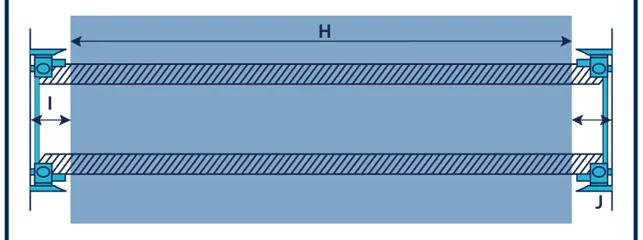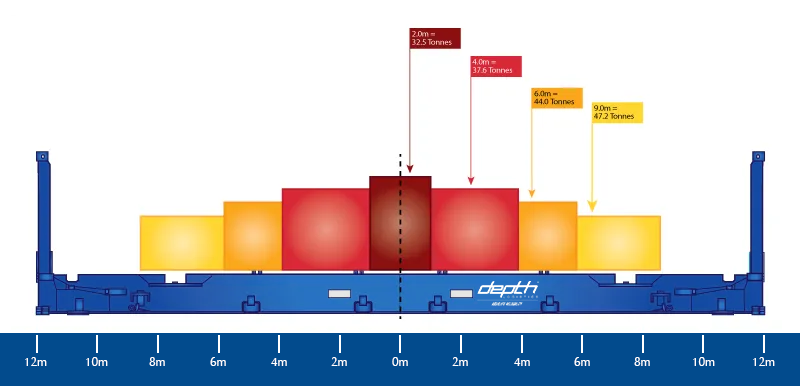Flatrack Packing Guide
Depth Logistics are experts in out of gauge and heavy lift cargo.
We have compiled information about shipping cargo via flatracks as general guidance to assist our clients with the correct securing of cargo to ensure safe shipment.
None of this information is intended to replace or supplement any relevant or applicable regulation, guideline or code of practice whether or not referred to by us. This information is non-exhaustive and seeks to increase awareness of basic procedures and no express or implied warranties or guarantees are made. Whilst we have made every effort to ensure the content provided is accurate, it may, nevertheless, contain errors and regulations subject to change. Therefore please note that Depth Defence Logistics does not assume any liability for the accuracy of the information and contents provided in this guide, or for any consequences resulting from using the information provided.
Carriage of cargo is subject to our standard trading terms and conditions and no information herein is intended to alter or amend these.
If you have any questions please do not hesitate to contact us and we will assist you.
Stuffing and Securing of your own cargo
It is imperative that all goods are placed in the right manner and are safely secured in line with requirements as vessel movements during ocean transport need to be considered when doing so.
Things to check prior to stuffing a flatrack
- Have a valid CSC/ISO placard (containing date of validity)
- Check the corner castings and structures
- Check floor, nails, holes, and for any traces of contamination or any post manufacture modifications
- Check condition of flatrack and lashing points
- Check integrity of endwalls and locks
- Check intended lashing equipment
- Check cargo weight distribution and that cargo is correctly positioned
Centre of gravity
The centre of gravity is the mean location of the weight of an object. When packing a flatrack you need to ensure that weight has been distributed suitably, both in length and cross direction so that the centre of gravity does not become off-centre.
The centre of gravity determines how stable your cargo is. If your cargo has not been secured correctly onto the flatrack it could easily become loose or fall over as the ship tilts in another direction whilst underway.
Where over-width cargo is concerned,blocking and bracing materials should not be packed within 30cm of the corner posts of the flatrack. This would prevent the flatrack from being loaded underdeck and loading of any such cargo on deck would come at an additional cost.
No. | Explanation | 20’ Flat | 40’ Flat |
|---|---|---|---|
H | Max. allowed length for overwidth cargo | 550 cm | 1160 cm |
I | Min. distance to flatracks outer end
| 30 cm | 30 cm |
J | Cell guides of the vessel under deck | ||
It is essential that out of gauge measurements recorded are accurate and include the lashing equipment. Incorrect declaration can result in miss-rating and non delivery of cargo.
It is important to note that the width of the floor is less than the container’s outer width (244 cms; 96″); therefore cargo might overlap the floor of the flatrack, but still be in-gauge. The only parts of the cargo or lashing materials that will be considered to be over-width are those which will overlap a virtual horizontal line between the outer edges of the corner posts.
Welding
Modifying the flatrack structure in any way including drilling holes and welding is strictly prohibited.
Weight distribution
Flatracks are specifically designed to carry heavier and more concentrated loads than standard equipment. It is the two bottom rails of the flat rack that provide the most strength; cargo must be resting on the rails or cross timbers can be used to transfer weight to the rails.
A maximum payload is marked on each flatrack, however, the maximum weight the unit can carry is also dependent on the length of the cargo actually resting on the rails.
When the cargo is spread over the entire length of the flatrack’s bottom rails, the maximum payload can be utilised. If the cargo you were intending to pack was very short (e.g resting on approx. 1m of length) then only half of the payload would be permitted.
For any questions surrounding this or specific requirements, don’t hesitate to reach out to a Depth Defence Logistics Representative.
Please refer to the diagram below for guidance on how to distribute the weight of your cargo. As illustrated, the permissible weight decreases as the cargo length decreases. As per the floor load limits in the diagram additional dunnage may be required for very dense cargo to distribute the weight as evenly as possible.
Note: This diagram is only a guide and it is important each piece of cargo is individually evaluated as per lashing, pressure points, weight distribution etc.
Bedding
You must not place heavy weights entirely on the wooden floor of the flatrack. The bedding must be laid out across the flat, and it needs to reach the main girders. This is important so that the bedding avoids point pressure.
Antislip material
Any contact between metal to metal is not acceptable. Wood dunnage or similar antislip materials (rubber) should be placed between cargo surfaces made of metal material and the flatrack bottom rails. The number of lashings required can be decreased if anti-slip material with high friction is utlised.
Lashing eyes
Flatracks are fitted with lashing eyes/facilities (D rings) generally with a capacity of SWL 5000kgs (this could vary depending on manufacturer). The main purpose of lashing is to make sure the cargo does not move against the side and length directions, and to ensure that it cannot tip over whilst in transit.
Cross lashing is the most efficient method in terms of lashing methods with lashing eyes. Direct lashings downwards increase friction and lashing lengthwise inhibits movement in length direction.
General Lashing
When securing cargo, materials which are suitable for the weight, size and construction of the cargo must be utilised. Please consider the points listed below
- Protect web lashings on sharp corners.
- Avoid mixing different lashing materials such as wires and web lashings on the same cargo, at least for securing in the same lashing direction.
- Different materials have different elasticity and create unequal lashing forces. Knotting in web lashings should be avoided as their breaking strength would be reduced by at least 50%.
- Secure Turnbuckles and shackles, so that they do not spin open.
- The strength of a lashing system is indicated by different terms like breaking strength (BS), lashing capacity (LC) or maximum securing load (MSL).
- For chains and web lashings the max. securing load is considered to be 50% of the breaking strength. The manufacturer will provide you with linear “BS/MSL” for direct lashing like cross lashings and/or system “BS/MSL” for loop lashings.
- Poor lashing angles, sharp edges or small radii will reduce the figures/tolerances indicated.
How to secure freight in length direction
A lashing system or a timber blocking and bracing system can be used to secure cargo in length direction.Timber bracing is more commonly used when cargo is crated; as a rule, the heavier the cargo is, the stronger the bracing needs to be.
Blocking should be braced against corner posts. Unpacked cargoes with suitable lashing points can be secured in length direction more effectively with direct lashings and in such cases no further bracing is necessary.
How to secure freight in a transverse direction
For securing against transverse and tipping forces, the best practice lashing method is securing with cross lashings.
There is a requirement for lashing eyes on the cargo for direct lashing systems. For calculation purposes use the “linear MSL” figures. The preferred lashing method for cargo without lashing eyes is the (half) loop lashing, also called Clashing system. Every lashing must be installed in pairs, with one half of the pair starting and returning to the same side. The other half of the pair starts and returns from the opposite side.
Use the “system MSL” figures provided by the manufacturer of the lashing material for calculation purposes. Friction lashings (those that go over the top of cargo) are not recommended as this system does not prevent transverse motion; they are however acceptable especially for extra-wide cases.
How to calculate how many lashings are required
As a recognised “Rule of Thumb” the number of lashings on each side of the cargo multiplied by the “linear or system MSL” must be higher than the weight of cargo. This is valid for optimum lashing system. The number of lashings has to be increased when these have poor angles, are bend around narrow radii (wire) or when there are other aspects of less than optimal lashing methods.
Pre-shipment Inspection
Depth Logistics can engage a Marine Surveyor on your behalf to conduct a pre-shipment inspection of the packed flatrack container/s.
Surveys are conducted prior to shipment to ensure the correct stowage and securing of irregular cargo on flatrack containers has been adhered to.The surveys also ensure the safety of the goods and its handling personnel, during transportation by road, rail or sea.
It is a good idea to engage a marine surveyor prior to shipment as if goods stowed/restrained do not meet regulatory requirements the transport provider and/or shipping company will refuse to load the freight.




